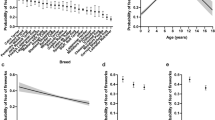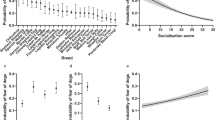Abstract
Little information is available on the response of vervet monkeys to different housing conditions or on the suitability of enrichment devices or methods for vervet monkeys. In this study, the authors evaluated the occurrence of stereotyped behavior in adult vervet monkeys under various conditions of housing and enrichment. The variables included cage size, cage level (upper or lower), enrichment with a foraging log, enrichment with an exercise cage and presence of a mate. The authors first determined the incidence of stereotyped behavior in captive-bred, singly housed adult female and male vervet monkeys. They then exposed monkeys to different housing and enrichment situations and compared the incidence of stereotyped behavior among the monkeys. The authors found that more females than males engaged in stereotyped behavior and that females, on average, engaged in such behavior for longer periods of time than males. Stereotyped behavior was most often associated with a small, single cage. The average amount of observed stereotyped activity in monkeys housed in a small cage was significantly lower when the monkeys had access to either a foraging log or an exercise cage. Stereotyped behavior was also lower in female monkeys that were housed (either with a male or without a male) in a larger cage. The least amount of abnormal behavior was associated with the largest, most complex and enriched housing situation. Males and females housed in cages on the lower level of two-level housing engaged in more stereotyped behavior than did monkeys housed in the upper level, regardless of the presence or type of enrichment provided.
This is a preview of subscription content, access via your institution
Access options
Subscribe to this journal
We are sorry, but there is no personal subscription option available for your country.
Buy this article
- Purchase on Springer Link
- Instant access to full article PDF
Prices may be subject to local taxes which are calculated during checkout







Similar content being viewed by others
References
Schein, M.W. & Hafez, E.S.E. The physical environment and behavior. in The Behaviour of Domestic Animals 2nd edn. (ed. Hafez, E.S.E.) 65–84 (Williams & Wilkins, Baltimore, 1969).
Kaumanns, W. General aspects of primate keeping and colony management. Primate Report 49, 47–53 (1997).
Novak, M.A., O'Neill, P. & Suomi, S.J. Adjustments and adaptations to indoor and outdoor environments: Continuity and change in young adult rhesus monkeys. Am. J. Primatol. 28, 125–138 (1992).
Bryant, C.E., Rupniak, N.M.J. & Iversen, S.D. Effects of different environmental enrichment devices on cage stereotypies and autoagression in captive cynomolgus monkeys. J. Med. Primatol. 17, 257–269 (1988).
Erwin, J. & Deni, R. Strangers in a strange land: abnormal behaviors or abnormal environments. in Captivity and Behavior: Primates in Breeding Colonies, Laboratories, and Zoos. (eds. Erwin, J., Maple, T. & Mitchell, G.) 1–28 (Van Nostrand Reinhold, New York, 1979).
Reinhardt, V. Refining the traditional housing and handling of laboratory rhesus macaques improves scientific methodology. Primate Report 49, 93–113 (1997).
Bayne, K. et al. The reduction of abnormal behaviors in individually housed rhesus monkeys (Macacca mulatta) with a foraging/grooming board. Am. J. Primatol. 23, 23–35 (1991).
Boccia, M.L. Long-term effects of a natural foraging task on aggression and stereotypies in socially housed pigtail macaques. Lab. Primate Newsletter 28, 18–19 (1989).
Foster, J.W. Behavior of captive animals. in Zoo and Wild Animal Medicine (ed. Fowler, M.E.) 20–31 (WB Saunders, Philadelphia, 1986).
Fritz, J., Nash, L.T., Alford, P.L. & Bowen, J.A. Abnormal behaviors, with a special focus on rocking and reproductive competence in a large sample of captive chimpanzees (Pan troglodytes). Am. J. Primatol. 27, 161–176 (1992).
Kessel, A. & Brent, L. The rehabilitation of captive baboons. J. Med. Primatol. 30, 71–80 (2001).
Lutz, C.K. & Farrow, R.A. Foraging device for singly housed longtailed macaques does not reduce stereotypies. Contemp. Topics Lab. Anim. Sci. 35, 75–78 (1996).
Novak, M.A., Kinsey, J.H., Jorgensen, M.J. & Hazen, T.J. Effects of puzzle feeders on pathological behavior in individually housed rhesus monkeys. Am. J. Primatol. 46, 213–227 (1998).
Lutz, C.K., Davies, E.B., Ruggiero, A.M. & Suomi, S.J. Early predictors of self-biting in socially-housed rhesus macaques (Macaca mulatta). Am. J. Primatol. 69, 584–590 (2007).
Baker, K.C. Straw and forage material ameliorate abnormal behavior in adult chimpanzees. Zoo Biol. 16, 225–236 (1997).
Bloomstrand, M., Riddle, K., Alford, P.L. & Maple, T.L. Objective evaluation of a behavioral enrichment device for captive chimpanzees (Pan troglodytes). Zoo Biol. 5, 293–300 (1986).
Brent, L. & Long, K.E. The behavioral response of individually caged baboons to feeding enrichment and the standard diet: a preliminary report. Contemp. Topics Lab. Anim. Sci. 34, 65–69 (1995).
Pyle, D.A. et al. Use of two food foraging devices by singly housed baboons. Lab. Primate Newsletter 35, 10–15 (1996).
Rosenblum, L.A. & Andrews, M.W. Environmental enrichment and psychological well-being of nonhuman primates. in Nonhuman Primates in Biomedical Research, Biology and Management. (eds. Benett, B.T., Abee, C.R. & Henrickson, R.) 101–112 (Academic, San Diego, 1995).
Harris, H.G. & Edwards, A.J. Mirrors as environmental enrichment for African green monkeys. Am. J. Primatol. 64, 459–467 (2004).
Reinhardt, V. & Reinhardt, A. The monkey cave: the dark lower-row cage. Lab. Primate Newsletter 38, 8–9 (1999).
Schapiro, S.J., Stavisky, R. & Hook, M. The lower-row cage may be dark but behavior does not appear to be affected. Lab. Primate Newsletter 39, 7–11 (2000).
South African National Standard for The Care and Use of Animals for Scientific Purposes. SANS 10386 (South African Bureau of Standards, Pretoria, South Africa, 2008).
Guidelines On Ethics For Medical Research: Use of Animals in Research and Training (South African Medical Research Council, Cape Town, South Africa, 2004).
Seier, J.V. & de Lange, P.W. A mobile cage facilitates periodic social contact and exercise for singly caged adult vervet monkeys. J. Med. Primatol. 25, 64–68 (1996).
Maki, S., Alford, P.L., Bloomsmith, M.A. & Franklin, J. Food puzzle device simulating termite fishing for captive chimpanzees. Am. J. Primatol. Suppl 1, 71–78 (1989).
Crockett, C.M., Bowers, C.L., Sackett, G.P. & Bowden, D.M. Urinary cortisol responses of longtailed macaques to five cage sizes, tethering, sedation and room change. Am. J. Primatol. 30, 55–74 (1993).
Hook, M.A. et al. Inter-group variation in abnormal behavior in chimpanzees (Pan troglodytes) and rhesus macaques (Macacca mulatta). Appl. Anim. Behav. Sci. 76, 165–176 (2002).
Author information
Authors and Affiliations
Corresponding author
Ethics declarations
Competing interests
The authors declare no competing financial interests.
Rights and permissions
About this article
Cite this article
Seier, J., de Villiers, C., van Heerden, J. et al. The effect of housing and environmental enrichment on stereotyped behavior of adult vervet monkeys (Chlorocebus aethiops). Lab Anim 40, 218–224 (2011). https://doi.org/10.1038/laban0711-218
Received:
Accepted:
Published:
Issue Date:
DOI: https://doi.org/10.1038/laban0711-218



